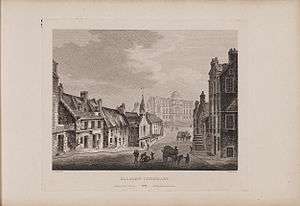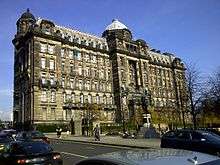Glasgow Royal Infirmary
| Glasgow Royal Infirmary | |
|---|---|
| NHS Greater Glasgow and Clyde | |
|
The Royal Infirmary's west-facing Centre Block, opened in 1914. | |
| Geography | |
| Location | Castle St, Glasgow, Scotland |
| Organisation | |
| Care system | NHS Scotland |
| Hospital type | Teaching |
| Affiliated university | University of Glasgow |
| Services | |
| Emergency department | Yes |
| Beds | 1077[1] |
| Speciality |
Cardiology, Plastic Surgery Gynaecology |
| History | |
| Founded |
1794 Rebuilt (I) 1909-1924 Rebuilt (II) 1974-82 |
| Links | |
| Website | Official Website |
| Lists | Hospitals in Scotland |
| Other links | WikiMapia: |
The Glasgow Royal Infirmary (GRI) is a large teaching hospital, operated by NHS Greater Glasgow and Clyde,[2][3] With a capacity of around 1000 beds, the hospital campus covers an area of around 8 hectares (20 acres), situated on the north-eastern edge of the city centre of Glasgow, Scotland.
History

Designed by Robert and James Adam, the original Royal Infirmary building was opened in December 1794. The infirmary was built beside Glasgow Cathedral on land that held the ruins of the Bishop's Castle, which dated from at least the 13th century but had been allowed to fall into disrepair. A Royal Charter was obtained in 1791, that granted the Crown-owned land to the hospital. The original Adams building had five floors (one underground) holding eight wards (giving the hospital just over a hundred beds) and a circular operating room on the fourth floor with a glazed dome ceiling. After a number of additional buildings were added, the first in 1816, a specialist fever block in 1829 and a surgical block in 1861. Following the amalgamation of the old St. Mungo's College of Medicine into the University of Glasgow Medical School in 1947, the old College buildings on Castle Street officially became part of the hospital campus, until their replacement by the New Building in the early 1980s.
New building
The original Adams building was replaced in 1914 with a new building designed by James Miller and opened by King George V. In 1924, the surgical block in which Joseph Lister had worked was also torn down to be replaced. In 1948 the hospital became part of NHS Scotland.
Post-war redevelopment
Visions of a brand new hospital on the site had been part of the Bruce Report as early as the late 1940s, but by 1974, the Greater Glasgow Health Board had formally begun plans for the replacement of the 1914 Miller buildings with a brand new building. This would be located on the north of the hospital site overlooking Alexandra Parade and the M8 motorway. The New Building was designed by Sir Basil Spence in a "modular" fashion, where new blocks could be easily added in phases as funding allowed. In the end, only the first phase of Spence's original design was implemented and was finally completed around 1982. Known as the Queen Elizabeth Building, it also incorporated new accommodation for the hospital's teaching departments, thus replacing the old St. Mungo's College buildings. The new complex is linked to the Surgical Block of the original Royal Infirmary building at basement level via a link corridor, with a further pedestrian entrance at lower basement level on Wishart Street (adjacent to the Necropolis). Since 1982 the pre-1915 buildings of the Infirmary have been protected as a category B listed building.[4]

After the closure of the Rutherglen Maternity Hospital and the Glasgow Royal Maternity Hospital, a new maternity block was added to the New Building; the Princess Royal Maternity building opened in 2001. Following the closure of Canniesburn Hospital, in 2005 the Jubilee building was opened, adding purpose-built Accident & Emergency facilities and a plastic surgery unit, this development also saw a new multi-storey car park built over the former site of St. Mungo's College. Following the transfer of the Golden Jubilee Hospital (formerly the infamous HCI Hospital) in Clydebank to public ownership, much of the Cardiology specialism was moved from GRI to the newer facility. The Infirmary now has over one thousand beds. Despite the new developments, the original Edwardian buildings continue to be used and are likely to remain in use for the foreseeable future.
Notable staff and research

In 1856, Joseph Lister became an assistant surgeon at the Infirmary and a professor of surgery in 1860. Running the new surgery block, Lister noted that about half of his patients died from sepsis. Having read Louis Pasteur's paper on rotting and fermentation caused by micro-organisms, Lister experimented to find ways to prevent sepsis. This experimentation lead to using carbolic acid to clean instruments and hands before and after surgery. Lister's methods were picked up around the world and he is now considered "the father of modern antisepsis".
In 1875, a student of Lister, William Macewen joined the Infirmary surgery as an assistant surgeon, becoming a full surgeon in 1877. While at the Infirmary he introduced the practice of doctors wearing sterilisable white coats, performed some of the first bone grafts, developing a one-piece osteotome and performing a number of studies on animal bones that lead to treatments for a number of bone-related maladies. His work was immortalised in a number of medical terms, such as MacEwen's triangle, MacEwen's operation and MacEwen's sign. A laboratory block, built in 1981 as part of the New Building of the period, bears his name.
In 1896, John Macintyre, Medical Electrician at the Infirmary, opened one of the first radiological departments in the world.
In 1908, one of MacEwen's students James Hogarth Pringle, developed the Pringle manoeuvre which is used to control bleeding during liver surgery.
Professor Ian Donald, working in the field of obstetrics and gynaecology, was one of the pioneers of diagnostic ultrasound.
References
- Foreman, Carol (2003). Lost Glasgow. Birlinn. ISBN 1-84158-278-6.
- Williams, David (1999). The Glasgow Guide. Birlinn. ISBN 0-86241-840-2
- Blakemore, Colin; Jenneth, Sheila (2001). The Oxford Companion to the Body. Oxford University. ISBN 0-19-852403-X.
- Pittock, Murray G. H. (2003). A New History of Scotland. Sutton. ISBN 0-7509-2786-0.
Footnotes
- ↑ "NHSGGC Job Description". NHS Greater Glasgow and Clyde. 2009. Retrieved 24 June 2010.
- ↑ "Records of Glasgow Royal Infirmary". NHS Greater Glasgow and Clyde Board Archive. Retrieved 29 December 2008.
- ↑ "Glasgow Royal Infirmary". Dr Foster. Retrieved 29 December 2008.
- ↑ "Royal Infirmary, Listed Building Report". Historic Scotland. Retrieved 22 November 2011.
External links
- Engraving of Glasgow Infirmary by James Fittler in the digitised copy of Scotia Depicta, or the antiquities, castles, public buildings, noblemen and gentlemen's seats, cities, towns and picturesque scenery of Scotland, 1804 at National Library of Scotland
Coordinates: 55°51′52.06″N 4°14′3.04″W / 55.8644611°N 4.2341778°W